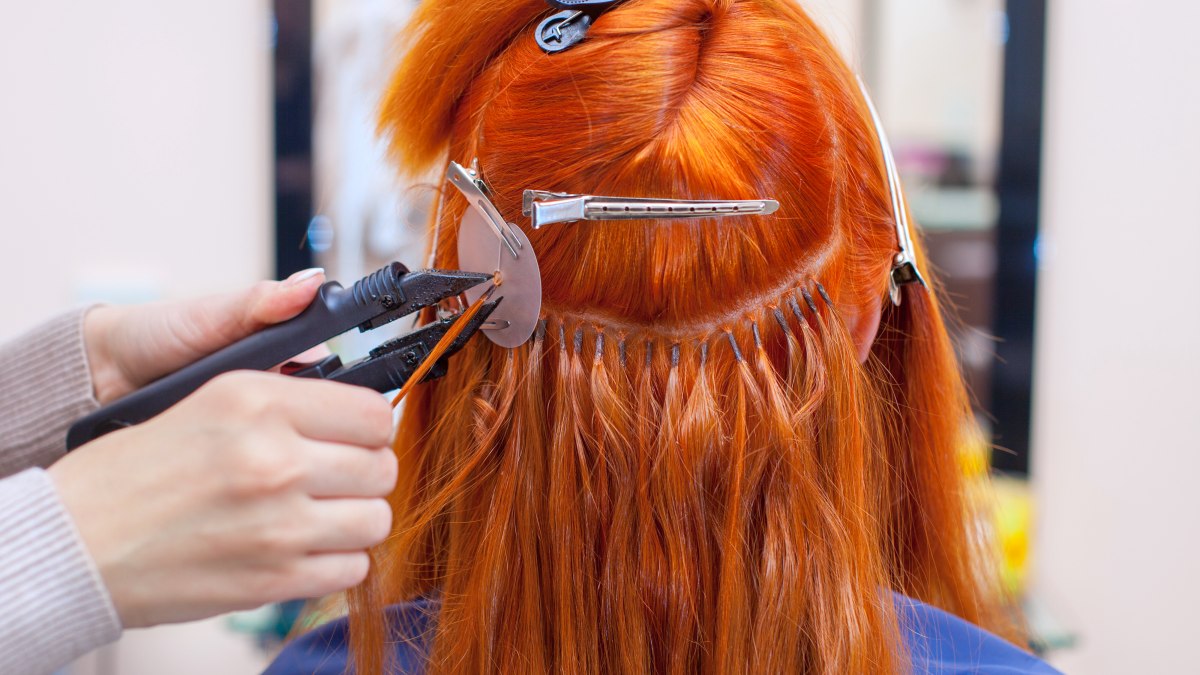How Long Does It Take to Do Hair Extensions: Complete Guide
How Long Does It Take to Do Hair Extensions
The application time for hair extensions can vary greatly depending on the type you choose. Here’s a rundown:
-
Clip-in extensions: These are the quickest and easiest to apply, taking only around 5-15 minutes to put in yourself.
-
Bonded or sewn-in extensions: These are more permanent options that require a salon visit for application. Expect to spend 2-4 hours for a full head, depending on the method used.
-
Hand-tied extensions: This meticulous method can take anywhere from 2-8 hours, depending on your hair’s length, volume, and the desired outcome. Read about Can You Bleach Wet Hair
Here’s a general rule: the simpler the application, the less time it takes. Clip-in extensions are the fastest, while bonded and hand-tied methods take considerably longer.
What Are Hair Extensions?
Hair extensions are strands of synthetic or natural hair that are attached to your natural hair to enhance its length and volume. They come in various styles and methods of application, making it easy to customize your look.
Why Do People Get Hair Extensions?
People opt for hair extensions for numerous reasons. Some want to add length and volume to their hair, while others desire a specific style or color without committing to permanent changes. Extensions can also be a solution for those dealing with hair thinning or loss. Discover about How to Get Hair Dye off Skin

Types of Hair Extensions
Clip-in Hair Extensions
Clip-in hair extensions are temporary extensions that you can easily clip into your hair. They are ideal for special occasions or for those who want to switch up their look without a long-term commitment.
Tape-in Hair Extensions
Tape-in extensions are semi-permanent and involve applying extensions with adhesive tape. They lie flat against your scalp, making them less noticeable than other types.
Sew-in Hair Extensions
Sew-in extensions, also known as weaves, involve braiding your natural hair and then sewing the extensions into the braids. This method is popular for its durability and natural appearance. Learn about How to Use Epsom Salt for Hair Growth
Fusion Hair Extensions
Fusion extensions use a keratin bond to attach the extensions to your natural hair. This method is known for its long-lasting results and natural look.
Micro-link Hair Extensions
Micro-link extensions involve attaching small sections of hair to your natural hair using tiny beads or links. This method does not require heat or glue, making it a safer option for your natural hair.
Factors Influencing the Time Required
Type of Hair Extensions
The type of hair extensions you choose significantly impacts the time required for installation. Temporary methods like clip-ins take less time compared to more permanent methods like fusion or sew-in extensions.
Hair Length and Thickness
Your hair’s length and thickness play a crucial role in the installation time. Longer and thicker hair requires more time to prepare and apply the extensions.
Stylist’s Experience and Skill Level
An experienced stylist can perform the installation more efficiently than a novice. Their skill level also ensures that the extensions are applied correctly and securely.
Preparation Time
Preparation includes washing, drying, and sometimes straightening your hair to ensure a smooth base for the extensions. This step is essential and can add to the overall time.
Clip-in Hair Extensions
Time Required for Installation
Clip-in extensions are the quickest to apply, typically taking about 10 to 30 minutes. The process involves sectioning your hair and clipping in the wefts.
Pros and Cons
Pros:
- Easy to apply and remove
- No long-term commitment
- Minimal damage to natural hair
Cons:
- Can feel bulky or uncomfortable
- May not blend seamlessly with natural hair
Tape-in Hair Extensions
Time Required for Installation
Installing tape-in extensions usually takes around 60 to 90 minutes. The process involves sectioning your hair, applying the adhesive tape, and pressing the extensions into place.
Pros and Cons
Pros:
- Lie flat and blend well with natural hair
- Reusable with proper care
- Quick to apply
Cons:
- Adhesive can weaken over time
- Requires professional removal to avoid damage
Sew-in Hair Extensions
Time Required for Installation
Sew-in extensions can take anywhere from 2 to 4 hours, depending on the stylist’s speed and the amount of hair being sewn in. The process involves braiding your natural hair and sewing the extensions into the braids.
Pros and Cons
Pros:
- Long-lasting and secure
- Ideal for thick, coarse hair
- Versatile styling options
Cons:
- Can be uncomfortable initially
- Puts tension on natural hair, potentially causing damage
Fusion Hair Extensions
Time Required for Installation
Fusion extensions are one of the most time-consuming methods, taking 3 to 6 hours to complete. The process involves sectioning your hair and bonding the extensions using a keratin adhesive.
Pros and Cons
Pros:
- Long-lasting and durable
- Natural look and feel
- Suitable for all hair types
Cons:
- Lengthy application process
- Potential for heat damage during installation
Micro-link Hair Extensions
Time Required for Installation
Micro-link extensions typically take 2 to 4 hours to install. The process involves attaching small sections of hair using tiny beads or links.
Pros and Cons
Pros:
- No heat or glue required
- Adjustable and reusable
- Less damaging than other methods
Cons:
- Beads can slip or become visible
- Requires regular maintenance
Preparation and Aftercare
Preparing Your Hair
Before getting extensions, it’s important to thoroughly wash and condition your hair. Avoid using heavy conditioners or oils that can interfere with the adhesive or bonding process.
Aftercare Tips for Longevity
Proper aftercare is crucial for maintaining the longevity of your extensions. Use sulfate-free shampoos, avoid excessive heat styling, and brush gently to prevent tangling.
Professional vs. DIY Installation
Benefits of Professional Installation
A professional stylist ensures that extensions are applied correctly and securely, reducing the risk of damage to your natural hair. They can also provide personalized advice and aftercare tips.
DIY Installation Considerations
While DIY installation can save money, it often results in less professional-looking results and may increase the risk of damaging your natural hair. It’s essential to follow instructions carefully if you choose to install extensions yourself.
Common Misconceptions
Instant Transformation Myths
Many believe that extensions offer an instant, flawless transformation. While they do provide immediate length and volume, achieving a natural look requires skillful blending and proper maintenance.
Maintenance and Upkeep Realities
Extensions require regular maintenance to stay looking their best. This includes periodic adjustments, proper washing, and careful styling to avoid damage.
Cost Considerations
Price Range for Different Types
The cost of hair extensions varies widely based on the type, quality, and length of the extensions. Clip-ins are generally the most affordable, while fusion and sew-in extensions tend to be more expensive.
Factors Affecting Cost
Factors such as the stylist’s expertise, the amount of hair needed, and the method of application all influence the overall cost of hair extensions.

Choosing the Right Extensions for You
Matching Hair Type and Lifestyle
Consider your hair type and lifestyle when choosing extensions. For example, if you lead an active lifestyle, you may prefer a method that is more secure and low-maintenance.
Consulting with a Professional
A consultation with a professional stylist can help you determine the best type of extensions for your needs and ensure that they are applied correctly.
Maintenance and Removal
How to Maintain Extensions
Regular maintenance includes gentle washing, avoiding heavy products, and protecting your extensions from heat damage. Follow your stylist’s aftercare recommendations for best results.
Time Required for Removal
Removing extensions can take anywhere from 30 minutes to a few hours, depending on the method. Professional removal is recommended to prevent damage to your natural hair.
Conclusion
Hair extensions offer a fantastic way to enhance your look, but the time required for installation varies significantly based on the type and method chosen. Whether you’re opting for the quick and easy clip-ins or the long-lasting fusion extensions, it’s essential to consider preparation, aftercare, and maintenance to keep your extensions looking their best.
FAQs
How often should hair extensions be replaced?
Hair extensions typically need to be replaced every 6 to 8 weeks, depending on the type and how well they are maintained.
Can I style my hair normally with extensions?
Yes, most hair extensions can be styled like your natural hair, but it’s important to use heat protectant products and avoid excessive heat styling.
Are hair extensions damaging to natural hair?
When applied and maintained correctly, hair extensions should not damage your natural hair. However, improper installation or neglecting aftercare can lead to damage.
How do I know which type of extensions is best for me?
Consulting with a professional stylist can help you determine the best type of extensions for your hair type, lifestyle, and desired look.
What should I do if my extensions start to feel uncomfortable?
If your extensions become uncomfortable, it’s best to visit your stylist to have them adjusted. Discomfort can be a sign that the extensions are too tight or not applied correctly.
